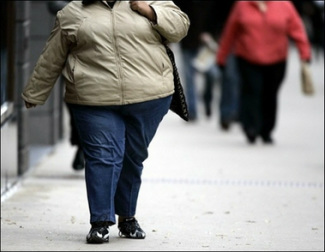 Tags: bodies, health/medicine, media, prejudice/discrimination, fat shaming, obesity, 00 to 05 mins Year: 2012 Length: 2:04 Access: msnbc Summary: This video is from the Today Show and can be used to highlight the very real health concerns associated with obesity, a problem which stems in part from living in a society that encourages people to move less and eat more. According to the news report, Alabama, Kentucky, Louisiana, Mississippi, and West Virginia are the "fattest" states, while Colorado, Massachusetts, and Vermont are the leanest. While there is a tendency for people to conclude the issue boils down to personal choices, this report draws attention to a more systemic reason for obesity. The lowest rates of obesity tend to occur in the wealthiest states, suggesting that leaner states are able to encourage exercise by building more pedestrian friendly infrastructure. Class discussion can also be pushed beyond the explicit message of the report, and students can be encouraged to critically examine the discourse on obesity in the United States. Much like this news report, people often connect weight and health, but it is simply not the case that being overweight is the same as being unhealthy. Similarly, students can also be encouraged to examine the phenomenon of fat shaming and how the widespread practice of photographing overweight bodies without heads (a.k.a., "headless fatties") reinforces the message that having an overweight body is so shameful, identities need to be disguised. Submitted By: Vicky Herbel, Associate Professor of Sociology
5 Comments
 Juan Carlos Claudio Tags: art/music, bodies, gender, sex/sexuality, social construction, dance, masculinity, performance, subtitles/CC, 06 to 10 mins Year: 2009 Length: 9:11 Access: YouTube Summary: This video features a dance piece entitled "The One & The Other," and is part of the graduate thesis of choreographer Juan Carlos Claudio (performing here with Graham Brown). In the piece, Claudio explores issues of masculinity and male-male friendships. He writes in his thesis: "The One & The Other came from a desire to portray the process of developing a healthy male relationship in which traits of masculinity and femininity are fully realized and expressed without fear or judgment. In presenting an example of this relationship I hoped to: 1) Challenge the old-fashioned rules of masculinity and the assumptions of male superiority, so that men could live happier and more fulfilled lives; 2) Expand men’s personal and emotional selves by helping them expose and realize their fears of close affection toward other men; and 3) Understand how men can create more genuine friendships by overcoming competitiveness, inexpressiveness, and other aspects of traditional masculine roles." This piece is not set to music. If you turn the volume up high you can hear the sounds of breathing and bodies in motion. After showing this performance in class, I ask students to discuss their emotional or visceral responses; they often say that it made them feel uncomfortable. This sets up a discussion of our social expectations of performances of masculinity, and can segue into a discussion of how we connect gender performance to ideas about sexuality. I ask the students to honestly assess whether they made assumptions about the sexuality of the performers based on their movements and interactions, and what led them to these assumptions. The video can also be used as an introduction to why bodies matter—I often ask students if they would feel more comfortable if it were two women dancers, or a male-female couple, and how their interpretations of certain movement sequences might be altered. Submitted By: Michelle Sandhoff 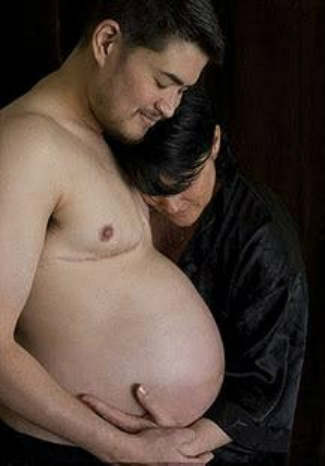 Tags: abortion/reproduction, aging/life course, biology, bodies, gender, health/medicine, lgbtq, marriage/family, science/technology, sex/sexuality, social construction, fatherhood, motherhood, parenting, pregnancy, stigma, transgender, subtitles/CC, 06 to 10 mins Year: 2012 Length: 10:33 Access: Vimeo Summary: This video portrays the experiences and voices of various transgender parents and their families, which includes their decisions to become parents, reflections on what it means to be a parent, experiences of being a child of a transgender parent, the social stigma attached to being a transgender parent (and transgenderism in general), and experiences with various reproductive technology options. The video is excellent for illustrating the diversity of family structures and alternative gender arrangements, and would be useful in a class on sociology of the family, reproduction, gender, or sex and sexuality. People in the video highlight the hyper-gendered experience of pregnancy and parenting, thereby illustrating the social construction of these core features of the life course; this social constructivist perspective stands in contrast to common biological understandings of pregnancy and parenting. This video would pair well with Laura Mamo's Queering Reproduction: Achieving Pregnancy in the Age of Technoscience, as well as with GLAD's recently released book, Transgender Family Law: A Guide to Effective Advocacy, which can offer a nice framework for discussing some of the legal issues and advocacy strategies that transgender people encounter in a family law context. The video is also available with Spanish subtitles. Submitted By: Valerie Chepp Image by Kristian Dowling/Getty Images for Beatie  Tags: art/music, bodies, discourse/language, gender, inequality, lgbtq, sex/sexuality, social mvmts/social change/resistance, gender expression, gender identity, identity politics, riki wilchins, queer, queer theory, transgender, subtitles/CC, 06 to 10 mins Year: 2012 Length: 6:35 Access: YouTube Summary: What better way to learn about the multiplicity of genders than to talk openly about gender identities and expressions, especially those which appear to challenge the prevailing myth of a tidy binary? The director of this short film asks eighteen trans activists, "How do you describe your gender identity?" and one by one, they respond. "Being a woman has got nothing to do with having a vagina," one activist remarks, then adds, "being a man has got nothing to do with having a penis." The clip is useful for underscoring the analytical distinction between gender identity, which refers to one's inner sense of being a man or a woman, and gender expression, which refers to one's fundamental sense of being masculine or feminine through performance (see Riki Wilchins, Queer Theory, Gender Theory). The impulse to police the gender binary, to ostracize and assault those whose gender identity and expression appear incongruent or fall outside the gender binary is an oppressive project, and as the activists featured in this clip suggest, there is both conformity and resistance to this project. To some extent, the activists who identify as transsexual women, work within the schema that posits "woman" as an identity which is meaningfully distinct from "man." In contrast, one activist appears to reject the binary altogether (1:04 to 2:38) and identifies only as a "trans person." To my mind, the collection of interviews begs a central and important question: Is it possible to move beyond gender as a fundamental basis of one's identity? Submitted By: Lester Andrist 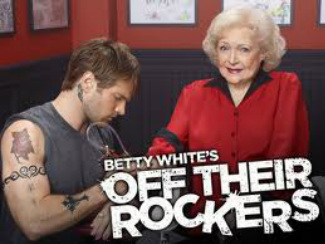 Tags: aging/life course, bodies, ageism, comedy, stereotypes, 21 to 60 mins Year: 2012 Length: 21:46 Access: no online access (trailer here) Summary: According to the show's creators, "'Betty White's Off Their Rockers'" takes senior stereotypes and blows them out of the water with a cast of sassy septuagenarians who are hip, sexy and ready to party!" The show features seniors who routinely prank young adults in hilarious situations. Season 1, episode 1 of the show offers a great platform for a discussion about ageism and stereotypes about the elderly (although all episodes to date also seem to be great for this). When using the episode in class, I had my students take notes on underlying stereotypes that make the show shocking and funny. We discussed that societal norms can sometimes most clearly be seen in showing their opposite. My students quickly picked up that the show would not be shocking if other age groups were doing these things. They also noticed that the show assumes elderly people are not sexual, do not have fun, and are not energetic or lively. It was a fun way to start a conversation about our section on aging. Submitted By: @iamtjones 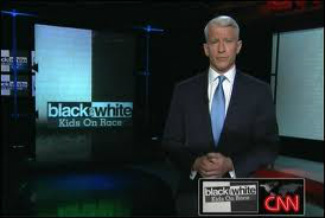 Tags: bodies, children/youth, inequality, prejudice/discrimination, race/ethnicity, implicit bias, interracial friendship, 06 to 10 mins Year: 2012 Length: 9:28 Access: CNN Summary: This Anderson Cooper clip examines children's views on race and interracial friendships. It shows how researchers viewed children (6-year olds and 13-year olds) ambiguous pictures of children with different colored skin, and asked them about what was happening in the pictures, if the children were friends, and if their parents would want them to be friends. It showed that both sets of children had clear understandings about race and that, at least the 13-year olds, had clearly experienced racist views from their families and their friends' families. Among the 6-year olds, young white children were more negative about interactions between children of different races and were far more likely to think black and white children would not be friends. The researcher discusses these experiences as part of an implicit bias, in which people are placed into stereotypes categories based on previous interactions and messages. See also this video of an experimental study showing children's racial bias, this video showing why racial diversity matters in forming view on race, and this video on the children's views on interracial friendships (all from Anderson Cooper). Submitted By: Paul Dean 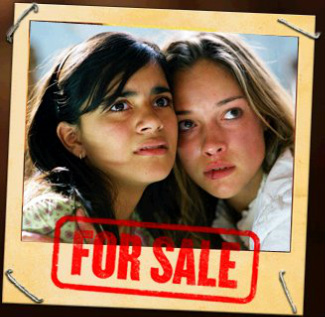 Tags: bodies, children/youth, crime/law/deviance, gender, sex/sexuality, violence, human trafficking, prostitution, rape, sex trafficking, sexual violence, violence against women, 00 to 05 mins Year: 2012 Length: 4:30 Access: New York Times Summary: In this Op-Ed Video, Pulitzer-prize winning columnist Nicholas Kristof interviews a survivor of childhood sex trafficking in Manhattan (see accompanying article). The woman was forced into prostitution at age 16, and at age 19, she was able to escape her pimp and gain her freedom. In the video, the woman describes how, as an emotionally and economically vulnerable teenager, she was tricked by an older man into a relationship and then forced into prostitution. Her pimp threatened her with violence, and she was sold from one pimp to another, and forced to have sex for money in New York and other cities along the East Coast. The video discusses how pimps recruit their girls and the role of websites like backpage.com in facilitating sex trafficking. Backpage (owned by Village Voice Media) features girls as young as 14 (although they are advertised as being at least 18) years old, makes $22 million/yr from its adult ads, and is now the "premier website for human trafficking in the United States." Many viewers may assume that victims sex trafficked in the US come from other countries, but in fact, the majority of sex trafficking victims in the US are domestic victims. Viewers may reflect on the role of the pimp in this process, and why pimps are often glorified in American popular culture. Submitted By: Paul Dean 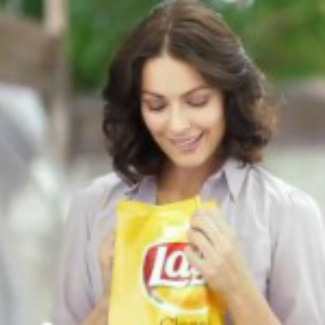 Tags: commodification, consumption/consumerism, bodies, emotion/desire, food/agriculture, gender, health/medicine, marketing/brands, media, eating disorders, subtitles/CC, 00 to 05 mins Year: 2011 Length: 0:33 Access: YouTube Summary: This commercial for LAY'S® potato chips can be used to illustrate the common practice among advertisers to represent women's consumption of junk food as a (commodified) act of romantic love, intimacy, or sexual pleasure. In this particular spot, shot entirely in slow motion with Al Green crooning his classic "I'm So In Love With You" in the background, anticipation builds as the woman prepares to encounter her salty prince, err...snack. As she opens the bag, a flirtatious smile spreads wide across her face. She performs all the ritualistic feminine acts of falling in love (bites at her lip, bats her lashes, averts her eyes), adhering to a familiar cultural narrative of a school girl falling in love: she's playful, coy, and unmistakably giddy. Across the bottom of the screen the following words appear: "one taste and you're in love." Feminists have well-documented the ways in which women are persistently depicted as being tormented by an obsessive relationship with food (e.g., Bordo 1998). Recently, scholars have pointed to the ways in which chocolate has been marketed to women, equating chocolate to delightful yet sinful indulgence, sex, and a pseudo form of female empowerment. In the article "Women and Food Chains: The Gendered Politics of Food," Allen and Sachs (2007) place this marketing strategy in a socio-health context, stating that "dieting, anorexia nervosa, bulimia, and obesity—all on the rise—mark the confused messages that women should have perfect (thin) bodies at the same time that they are encouraged to over consume and indulge in junk food. Advertising and media play an enormous role in perpetuating women's obsession with thinness" (2). As these commercials about junk food suggest, advertising and the media also play a role in perpetuating the message that, for women, the junk food eating experience is similar to that of sex, love, and intimacy, all of which perpetuate a complex and often unhealthy relationship with food. In another version of this commercial, Queen's "Crazy Little Thing Called Love" plays in the background. Submitted By: Valerie Chepp 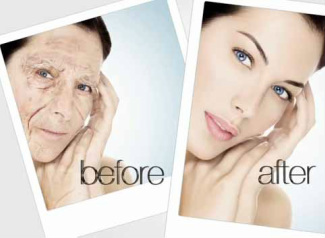 Tags: aging/life course, bodies, consumption/consumerism, discourse/language, gender, marketing/brands, media, race/ethnicity, social construction, comedy, feminism, reflexivity, representation, self-objectification, sexism, sexual objectification, 00 to 05 mins Year: 2011 Length: 2:14 Access: Vimeo Summary: It is not uncommon to read about Photoshop mishaps these days, and there is even a website devoted to posting pictures of bodies that have been butchered by the software, where the overzealous rearrangement of pixels has inadvertently created an oversized hand or a clavicle that appears to fold up like an accordion. Ralph Lauren's infamous picture of model Filippa Hamilton-Palmstierna was heavily retouched, leaving her torso smaller than her head, and as Rachel Maddow points out (here), in all probability, this is not a combination that exists in nature--_at least outside the insect world" (Jean Kilbourne is also critical of the Hamilton-Palmstierna photo in her documentary, Killing Us Softly 4). The often humorous attention paid to Photoshop mishaps threatens to overshadow the very troubling practice of distorting photographed bodies in popular media, and then peddling those distorted images to the public as real. In this post's featured clip, filmmaker Jesse Rosten creates what appears to be just another commercial for a product that promises youth and beauty in a bottle, but after seeing that the product is named Fotoshop, it's easy to deduce that Rosten's pitch is pure satire aimed at lambasting the similarly named software. Witty zingers abound in the clip (e.g., "Just one application of Fotoshop can give you results so dramatic they're almost unrealistic" and "Brighten eyes, whiten teeth, even adjust your race!"), and it offers a nice foundation for beginning a conversation about Photoshop's impact on the standards men and women are coming to have for their bodies and how Photoshop's ubiquity might be tied up with reflexivity, which denotes the growing awareness people have of their bodies. I find it useful to ask students to articulate what all the fuss is about? What's the harm? The Sociological Cinema has explored the widespread use of Photoshop as a social problem in other videos, but perhaps none is more effective than the Dove Evolution commercial from 2006. Note too that this clip joins a number of other clips on The Sociological Cinema, which deploys satire as a means of critiquing the values promoted in commercials (here and here). Submitted By: Lester Andrist 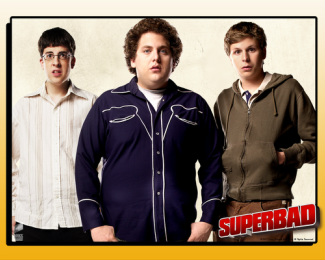 _Tags: bodies, consumption/consumerism, gender, health/medicine, knowledge, political economy, biopolitics, feminism, medicalization, menarche, menstruation, menses, patriarchy, stigma, taboo, 00 to 05 mins Year: 2007 Length: 3:57 Access: YouTube Summary: In this scene from the movie Superbad, Seth finds himself dancing close to a woman at a party and winds up with her menstrual blood on his pant leg. A group of boys at the party spot the blood and deduce the source, and thus begins one of the film's signature gags: an awkward adolescent deals with what is supposed to be an awkward adolescent moment. In addition to Seth's panicked yet futile attempts to stave off humiliation are his efforts to work through the disgust of this unambiguous contamination. "Someone period-ed on my fucking leg!" he cries while gagging. Feminists have long been critical of this all-too-common fear of menstrual contamination and point to its roots in patriarchy. It is an instance of re-imagining the natural human experience of menstruation as a pathology, which can only be experienced with a measure of shame and dread. But more than men simply pathologizing a distinctly feminine experience, the pervasive fear of menstruation also fuels a multibillion dollar industry, which produces and markets hundreds of products designed to manage and even suppress menstruation (e.g., Lybrel and Seasonique). In an interview (here) about her recent book, New Blood: Third Wave Feminism and the Politics of Menstruation, sociologist Chris Bobel nicely articulates the connection between menstrual anxiety and corporate profit: "The prohibition against talking about menstruation—shh…that’s dirty; that’s gross; pretend it’s not going on; just clean it up—breeds a climate where corporations, like femcare companies and pharmaceutical companies, like the makers of Lybrel and Seasonique, can develop and market products of questionable safety. They can conveniently exploit women’s body shame and self-hatred. And we see this, by the way, when it comes to birthing, breastfeeding, birth control and health care in general. The medical industrial complex depends on our ignorance and discomfort with our bodies." The clip would work nicely with Bobel's book and as a means of opening a discussion about biopolitics, and specifically, the intensity with which women's bodies are scrutinized and managed by both the state and economy. I would like to thank Aimee Koon for suggesting this clip. Submitted By: Lester Andrist |
Tags
All
.
Got any videos?
Are you finding useful videos for your classes? Do you have good videos you use in your own classes? Please consider submitting your videos here and helping us build our database!
|
 RSS Feed
RSS Feed
